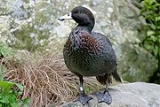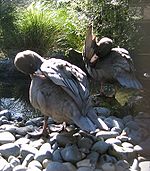
Blue Duck
Encyclopedia
The Blue Duck is a member of the duck
, goose
and swan
family
Anatidae
endemic to New Zealand. It is the only member of the genus Hymenolaimus, placed in the shelduck
subfamily Tadorninae
after previously being considered part of the paraphyletic "perching duck
" assemblage. The Māori
name, sometimes used in English, is whio, which is an onomatopoetic rendition of the males' call.
The Blue Duck features on the reverse side of the New Zealand $10 note
.
 The Blue Duck is a dark slate-grey with a chestnut-flecked breast and a paler bill and eye. The pinkish-white bill has fleshy flaps of skin hanging from the sides of its tip. The male's call is an aspirated whistle, and the female's is a rattling growl. The Blue Duck is born with a green beak for just 8 hours after birth; where it then develops to its final colour.
The Blue Duck is a dark slate-grey with a chestnut-flecked breast and a paler bill and eye. The pinkish-white bill has fleshy flaps of skin hanging from the sides of its tip. The male's call is an aspirated whistle, and the female's is a rattling growl. The Blue Duck is born with a green beak for just 8 hours after birth; where it then develops to its final colour.
is an endemic
resident breeder in New Zealand
, nesting in hollow logs, small caves and other sheltered spots. It is a rare duck, holding territories on fast flowing mountain rivers. It is a powerful swimmer even in strong currents, but is reluctant to fly. It is difficult to find, but not particularly wary when located.
food with introduced trout
, and damming of mountain rivers for hydroelectric schemes. It is listed as Nationally Endangered in the New Zealand Threat Classification System
. In 2009 the New Zealand Department of Conservation
started a ten-year recovery programme to protect the species at eight sites using predator control and then re-establish populations throughout their entire former range.
Duck
Duck is the common name for a large number of species in the Anatidae family of birds, which also includes swans and geese. The ducks are divided among several subfamilies in the Anatidae family; they do not represent a monophyletic group but a form taxon, since swans and geese are not considered...
, goose
Goose
The word goose is the English name for a group of waterfowl, belonging to the family Anatidae. This family also includes swans, most of which are larger than true geese, and ducks, which are smaller....
and swan
Swan
Swans, genus Cygnus, are birds of the family Anatidae, which also includes geese and ducks. Swans are grouped with the closely related geese in the subfamily Anserinae where they form the tribe Cygnini. Sometimes, they are considered a distinct subfamily, Cygninae...
family
Family (biology)
In biological classification, family is* a taxonomic rank. Other well-known ranks are life, domain, kingdom, phylum, class, order, genus, and species, with family fitting between order and genus. As for the other well-known ranks, there is the option of an immediately lower rank, indicated by the...
Anatidae
Anatidae
Anatidae is the biological family of birds that includes ducks, geese and swans. The family has a cosmopolitan distribution, occurring on all the world's continents except Antarctica and on most of the world's islands and island groups...
endemic to New Zealand. It is the only member of the genus Hymenolaimus, placed in the shelduck
Shelduck
The shelducks, genus Tadorna, are a group of large birds in the Tadorninae subfamily of the Anatidae, the biological family that includes the ducks and most duck-like waterfowl such as the geese and swans....
subfamily Tadorninae
Tadorninae
The Tadorninae is the shelduck-sheldgoose subfamily of the Anatidae, the biological family that includes the ducks and most duck-like waterfowl such as the geese and swans....
after previously being considered part of the paraphyletic "perching duck
Perching duck
The perching ducks were previously treated as a small group of ducks in the duck, goose and swan family Anatidae, grouped together on the basis of their readiness to perch high in trees...
" assemblage. The Māori
Maori language
Māori or te reo Māori , commonly te reo , is the language of the indigenous population of New Zealand, the Māori. It has the status of an official language in New Zealand...
name, sometimes used in English, is whio, which is an onomatopoetic rendition of the males' call.
The Blue Duck features on the reverse side of the New Zealand $10 note
Banknotes of the New Zealand dollar
-Pre-dollar:Prior to 10 July 1967, the New Zealand pound, using the £sd system, was the main currency of New Zealand. Since 1934, banknotes of the New Zealand pound were issued by the Reserve Bank of New Zealand, and came in denominations of 10s, £1, £5, £10, and £50.-First issue: 1967 -...
.
Description

Ecology and behaviour
This speciesSpecies
In biology, a species is one of the basic units of biological classification and a taxonomic rank. A species is often defined as a group of organisms capable of interbreeding and producing fertile offspring. While in many cases this definition is adequate, more precise or differing measures are...
is an endemic
Endemic (ecology)
Endemism is the ecological state of being unique to a defined geographic location, such as an island, nation or other defined zone, or habitat type; organisms that are indigenous to a place are not endemic to it if they are also found elsewhere. For example, all species of lemur are endemic to the...
resident breeder in New Zealand
New Zealand
New Zealand is an island country in the south-western Pacific Ocean comprising two main landmasses and numerous smaller islands. The country is situated some east of Australia across the Tasman Sea, and roughly south of the Pacific island nations of New Caledonia, Fiji, and Tonga...
, nesting in hollow logs, small caves and other sheltered spots. It is a rare duck, holding territories on fast flowing mountain rivers. It is a powerful swimmer even in strong currents, but is reluctant to fly. It is difficult to find, but not particularly wary when located.
Status
The Blue Duck is a very localised species now threatened by predation from introduced mammals especially stoats, competition for its invertebrateInvertebrate
An invertebrate is an animal without a backbone. The group includes 97% of all animal species – all animals except those in the chordate subphylum Vertebrata .Invertebrates form a paraphyletic group...
food with introduced trout
Trout
Trout is the name for a number of species of freshwater and saltwater fish belonging to the Salmoninae subfamily of the family Salmonidae. Salmon belong to the same family as trout. Most salmon species spend almost all their lives in salt water...
, and damming of mountain rivers for hydroelectric schemes. It is listed as Nationally Endangered in the New Zealand Threat Classification System
New Zealand Threat Classification System
The New Zealand Threat Classification System is used by the Department of Conservation to assess conservation priorities of species in New Zealand....
. In 2009 the New Zealand Department of Conservation
New Zealand Department of Conservation
The Department of Conservation , commonly known by its acronym, "DOC", is the state sector organisation which deals with the conservation of New Zealand’s natural and historic heritage...
started a ten-year recovery programme to protect the species at eight sites using predator control and then re-establish populations throughout their entire former range.
External links
- ARKive: Images and movies of the Blue Duck (Hymenolaimus malacorhynchos)
- BirdLife Species Factsheet.
- Blue duck/Whio at the Department of Conservation
- Blue Duck Project Charitable Trust
- Central North Island Blue Duck Trust

